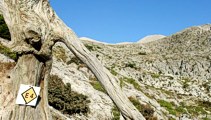The day dawned with a cloudless blue sky. I was lucky. The route starts with a gentle two km warm up across the Niato plateau before turning more vicious. The next phase is a very steep 700 meter climb up the north east ridge of Kastro. One of the pluses is that you are doing this in the relative cool of the morning - one of the minuses is that you will probably be carrying something like five litres of water (at least three litres more than usual) in case there is a problem with supply at Katsiveli. All in all, it took me three hours to get from 1250 to 1900 metres, over a distance of about 4.5 kms. - slow going !
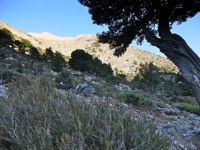
The start of the climb
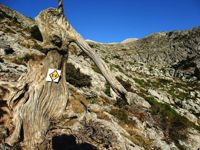
The path is well signed
The next challenge is a traverse across a one km, very steep, scree slope. This is little more than a narrow, vertigo-inducing, goat path losing height gently towards a col which is the entrance to the central desert massif. It is much easier doing it this way than from west to east (gently uphill) but it is still tough on the ankles as they are twisted sideways.
Full marks to the EOS in Chania for the signing all the way to Katsiveli. One of their teams has worked very hard carrying paint all the way through this tough route. Sadly, a lot of the poles which had been there three years ago, and which I had marked on the GPS, have been destroyed by the harsh weather conditions at these altitudes; it is the poles which are easiest to spot - especially on the skyline. You wonder how long these new paint marks will last.

The scree slope leading to the Koutala saddle - top left
Having done a lot of "up", there is then quite a lot of down (to about 1700 m) which is demoralising because the highest point is going to be 2060 metres, so there is still lot of "up" to come on tired legs, though the water weight is gradually reducing (I got through two litres of water and one litre of isotonic drink on this day's walking). The reward is an extraordinary landscape quite unlike any other I have seen. The definitive book on the subject is called "The Making of the Cretan Landscape" which explains the extraordinary variety of shapes and colours in this mountain desert.
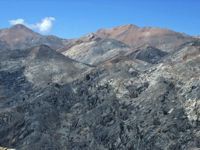
An astonishing landscape
looking southwest

Magic views down to the north coast
looking northeast
There are few sheep and goats here as the stock stations on the Niato plateau have better grazing within easier reach. The only sign of life were four young lads out hunting with two dogs. Joseph at Kallerghi had told me, when I phoned him, to keep an eye out for a red rucksack left behind by the German walker who had got lost and run out of water a month earlier. He had been helicoptered off and was lucky not to lose his life - a salutary lesson on how to treat these mountains with huge respect.
The path is not always obvious on the ground but Anavasi has a 1:25,000 map with the path clearly marked, so with basic navigation techniques and good visibility you can get through with the help of the E4 signs. In poor visibility there is a real risk of falling into classic limestone sink holes where you would be trapped without phone signal and little chance of being heard - a grisly end.
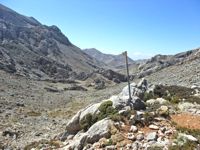
On the way down to Livada
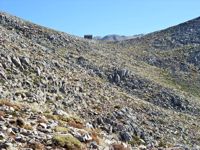
The EOS hut at Katsiveli
After nine hours of tough terrain you are counting down the kilometres to the hut at Katsiveli. Then suddenly you are rewarded with magic views down to the north coast - Chania and the Akrotiri - as you cross the "sideroporti", below Grias Soros, on the way down to the Livada valley bottom.
Then, after a final heart-breaking pull up to the saddle below Svourichti, you see the two "alpine" huts: the main one usually locked unless you coincide with a group, and the baby one, which has eight bunks but no water, a bit further down the slope.
For the first time in my experiences up here, fresh spring water was running into the animals' drinking trough. This is water piped down from a spring high on Svourichti by way of the shepherd's hut close to the little "alpine" hut and is delicious, cool and clean. But you cannot rely on it always running - in June the spring can be covered in snow and inaccessible; by late August it can have run dry.
This was a long and tiring day - but very rewarding. I slept soundly with the alarm set for another early start next morning.
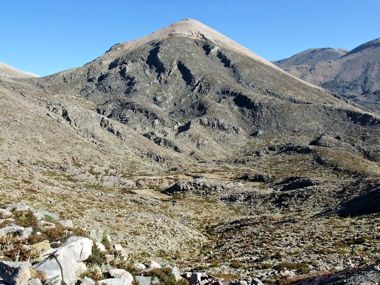
The small hut sits on the rocks in the centre of the photo
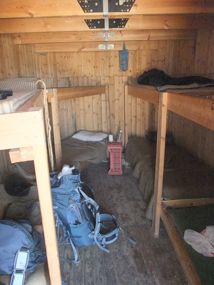
Inside the small hut
